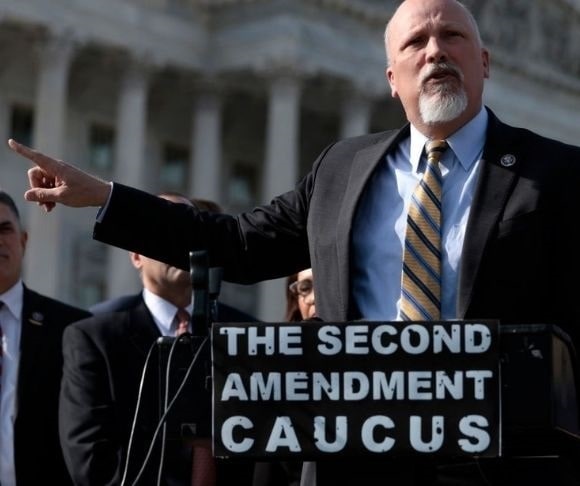Does allowing people to carry firearms without permits – or even the responsibility to self-report during interactions with the police when armed – really make life more dangerous for law enforcement officers and civilians alike? So goes the argument made by the “common-sense gun control” advocates, including many in law enforcement – but do the actual facts agree? That’s the constitutional carry conundrum – the same argument we hear anytime the issue comes up. Ohio’s recent rejection of permit and reporting requirements is just the latest of many, and it almost certainly won’t be the last. So let’s dust off those critical thinking skills, dig into the numbers, and find the truth.
Common Sense and Simple Math

Mike DeWine (Photo by Gregory Shamus/Getty Images)
Ohio Governor Mike DeWine signed into law a bill that removes the requirement that armed citizens over the age of 21 acquire a permit to carry a firearm and the mandate that all armed drivers volunteer that information when pulled over, whether asked or not. Many “common-sense gun control” advocates, especially those who work in law enforcement, are up in arms over it, if you’ll pardon the pun.
Common sense should tell us that requiring permits wouldn’t stop anyone who already plans to break the law with a firearm. As for self-reporting mandates, putting a weapon into play – even if that just means alerting someone else of the presence – increases the potential one will be used in any situation. Imagine a typical traffic stop. The officer initiates the conversation – perhaps there’s a ticket, maybe not – and then the driver is sent on his or her way. Unless there’s some reason to search the vehicle, why does the officer need to know if it contains a firearm?
Now, same scenario – but this time, the civilian is asked if any weapons are in the vehicle or volunteers the information out of obligation to the law. Maybe things go the same way – assuming, of course, this individual is wise enough not to self-report by simply blurting out, with no other context, “I have a gun” – but what if they don’t? For that matter, what if they do? Police officers are just people with jobs. Yes, they’re trained, but they’re still people who very much would like to go home at the end of the shift, and even a simple traffic stop can end the life of the anyone unlucky enough to pull over the wrong person. Ideally, the information – delivered in the proper manner – doesn’t change the outcome, and often enough, it doesn’t. However, it almost certainly will change the level of tension in the interaction, at least for most people. Even if things don’t go horribly awry completely by accident, there is no positive outcome to this situation that wouldn’t have been made more likely simply by never mentioning the firearm. Returning once again to the force of law upon those already intending to break it, why would anyone planning to shoot a police officer feel obligated to first give a warning? But enough theory; let’s look at some more objective and measurable facts.
A good source to consult for police officers killed in the line of duty is Officer Down Memorial Page. Results can be searched by year, state, cause of death, or any combination of the above. There were 13 states that allowed permitless carry prior to 2020; those with zero police shooting deaths in the two-year span are highlighted with bold text:
- Alaska (2003): 0 in 2020 and 0 in 2021
- Arkansas (2013): 3 in 2020 and 0 in 2021
- Arizona (2010): 3 in 2020 and 1 in 2021
- Idaho (2016): 0 in 2020 and 0 in 2021
- Kansas (2015): 1 in 2020 and 0 in 2021
- Kentucky (2019): 0 in 2020 and 1 in 2021
- Maine (2015): 0 in 2020 and 0 in 2021
- Mississippi (2016): 1 in 2020 and 1 in 2021
- Missouri (2015): 2 in 2020 and 1 in 2021
- New Hampshire (2017): 0 in 2020 and 0 in 2021
- Oklahoma (2019): 1 in 2020 and 0 in 2021
- Vermont (2019): 0 in 2020 and 0 in 2021
- West Virginia (2016): 2 in 2020 and 0 in 2021
Five of these states didn’t lose a single law enforcement officer to gunfire in 2020 or 2021, and across the remaining eight, there were 17 deaths in two years.
Alabama and Ohio have signed constitutional carry into law, but those changes won’t be in effect until January 1, 2023, and June 12, 2022, respectively. Alabama saw two cops killed by gunfire in 2020 and three in 2021, while Ohio lost two each year.
 Now let’s look at those that dropped permit requirements in 2020 and 2021. Iowa’s single officer killed in action with a gun was in 2021, but it happened before the change went into effect July 1. Montana joined this club June 1, 2021, and had zeros for both years examined. North Dakota had one death in 2020, which was before the rule change on July 1, 2021. South Dakota made the move July 1, 2021, and had zeroes for both years. Utah had a single death in 2020, which was before the May 5, 2021 date of effect. Finally, Wyoming, which went permitless July 1, 2021, had no cops killed by firearms in either year.
Now let’s look at those that dropped permit requirements in 2020 and 2021. Iowa’s single officer killed in action with a gun was in 2021, but it happened before the change went into effect July 1. Montana joined this club June 1, 2021, and had zeros for both years examined. North Dakota had one death in 2020, which was before the rule change on July 1, 2021. South Dakota made the move July 1, 2021, and had zeroes for both years. Utah had a single death in 2020, which was before the May 5, 2021 date of effect. Finally, Wyoming, which went permitless July 1, 2021, had no cops killed by firearms in either year.
Only two constitutional carry states that recently made the change saw an increase in officers killed by gunfire after the date of effect: Tennessee and Texas. Tennessee’s law began July 1, 2021; there was one officer shot dead after that and none earlier in the year or in 2020. Texas, however, was a mess. In 2020, seven police officers were shot dead in the line of duty. In 2021, there were eight – four before the change and four after. But since the law went into effect September 1, that second half represents a higher average per month.
Let’s review: There are now 21 constitutional carry states, with two more just waiting for already-signed laws to go into effect and another three – at least – that seem likely to join the club in the near future. Of those, 13 held the status before 2020. There are 11 constitutional carry states that either didn’t have a single officer shot dead in 2020 or 2021 or, if they did, it was before the change. Of the other 27 states, just seven can say the same.
The State of the Stats
Now let’s convert that data into statistics that are, perhaps, a bit easier to digest. For this calculation, it seems fair to count a state that adopted constitutional carry in 2020 or 2021 in both groups, based upon when the shootings – if any – occurred in relation to the law change. Additionally, the nation’s capital gets to be its own state – but don’t worry, it’s only for this little exercise. Remember: The range is 2020 to 2021.
- States allowing permitless carry: 41%
- States not allowing permitless carry – including Alabama and Ohio: 59%
- Constitutional carry states without any cops killed by gunfire: 52%
- Other states without any cops killed by gunfire: 28%
- Total number of officers shot dead in constitutional carry states: 19 of 101 (19%)
- Total number of officers shot dead in other states: 82 of 101 (81%)
 For a final little factoid, constitutional carry states also tended to have fewer officers killed each. Of the ten that did lose cops to gunfire, five had just one (50%), two had two (20%), two had three (20%), and only Texas had four (10%). Of the other 26 states with officers shot dead in the line of duty in 2020 or 2021, nine (including pre-constitutional carry Texas) had four or more (34%), while 11 (42%) had only one.
For a final little factoid, constitutional carry states also tended to have fewer officers killed each. Of the ten that did lose cops to gunfire, five had just one (50%), two had two (20%), two had three (20%), and only Texas had four (10%). Of the other 26 states with officers shot dead in the line of duty in 2020 or 2021, nine (including pre-constitutional carry Texas) had four or more (34%), while 11 (42%) had only one.
How Civilians Fared
For civilian firearms homicides, we’re using the CDC’s report on multiple causes of death by state in 2020, with the filter set to only include intentional shootings that weren’t self-inflicted. The data for 2021 is not yet available. For the sake of both brevity and simplicity, let’s rank the states and the District of Columbia from highest to lowest in firearm homicides per 100,000. Here’s the top ten, including each entry’s raw total:
- District of Columbia – 22.0, total of 157
- Mississippi – 16.8, total of 499
- Louisiana – 16.1, total of 747
- Alabama – 11.5, total of 564
- Missouri – 11.1, total of 683
- South Carolina – 10.1, total of 526
- Tennessee – 9.5, total of 652
- Arkansas – 9.3, total of 282
- Illinois – 9.3, total of 1,167
- Maryland – 8.7, total of 526
Of the ten, only three – Mississippi, Missouri, and Arkansas – allowed permitless carry in 2020. Of the remaining 13 constitutional carry states at the time, just three more – Kentucky, Oklahoma, and Kansas – fall in the worst half, and the last just barely at number 24.
The next time someone says that requiring conceal carry permits and mandatory self-reporting – or any other gun control law, for that matter – is just common sense, put it to the test. It’s amazing what just a little critical thinking, not to mention a good long look at the numbers, can reveal.
~ Read more from James Fite.




